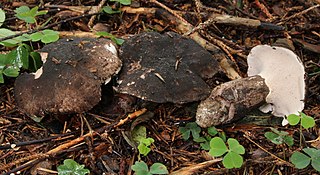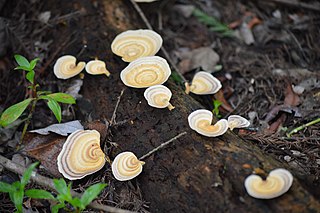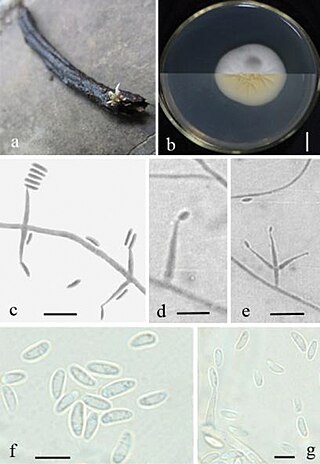Related Research Articles
Edred John Henry Corner FRS was an English mycologist and botanist who occupied the posts of assistant director at the Singapore Botanic Gardens (1929–1946) and Professor of Tropical Botany at the University of Cambridge (1965–1973). Corner was a Fellow of Sidney Sussex College from 1959.

Livistona is a genus of palms, the botanical family Arecaceae, native to southeastern and eastern Asia, Australasia, and the Horn of Africa. They are fan palms, the leaves with an armed petiole terminating in a rounded, costapalmate fan of numerous leaflets.

Verticillium is a genus of fungi in the division Ascomycota, and are an anamorphic form of the family Plectosphaerellaceae. The genus used to include diverse groups comprising saprobes and parasites of higher plants, insects, nematodes, mollusc eggs, and other fungi, thus the genus used to have a wide-ranging group of taxa characterised by simple but ill-defined characters. The genus, currently thought to contain 51 species, may be broadly divided into three ecologically based groups - mycopathogens, entomopathogens, and plant pathogens and related saprotrophs. However, the genus has undergone recent revision into which most entomopathogenic and mycopathogenic isolates fall into a new group called Lecanicillium.

Saribus rotundifolius, also known as the footstool palm, is a common fan palm found in Southeast Asia. It is a member of the genus Saribus.
Andreaeobryum is a genus of moss with a single species Andreaeobryum macrosporum, endemic to Alaska and western Canada. The genus is placed as a separate family, order and class among the mosses.

The Lecanoraceae are a family of lichenized fungi in the order Lecanorales. Species of this family have a widespread distribution.

Boletopsis is a genus of mycorrhizal fungi in the family Bankeraceae. The genus was circumscribed by Swiss mycologist Victor Fayod in 1889, with Boletopsis leucomelaena as the type species.

Pannaria is a genus of lichen-forming fungi in the family Pannariaceae. The widespread genus contains an estimated 51 species, found primarily in tropical regions.
Bellemerella is a genus of fungi in the family Verrucariaceae. All four species are lichenicolous, meaning they grow parasitically on other lichens.
Colensoniella is a genus of fungi in the class Dothideomycetes. The relationship of this taxon to other taxa within the class is unknown. A monotypic genus, it contains the single species Colensoniella torulispora.
Scotiomyia is a genus of flies in the family Dolichopodidae. It is distributed in Papua New Guinea, Singapore and China.

Microporellus is a genus of poroid fungi in the family Polyporaceae.
Aliquandostipitaceae is a family of fungi in the Ascomycota, class Dothideomycetes. The family was described by Patrik Inderbitzin in 2001, and the order Jahnulales was created in 2002 to accommodate the family. The distinguishing characteristic for members of the family are the unusually wide hyphae that support the spore-bearing structures, and the presence of ascomata both with and without stalks. The genus Aliquandostipe has a pantropical distribution, having been found in Central America and southeast Asia; Jahnula has a wider distribution. Species in the family are saprobic, and are typically found growing on rotting wood.
Murphydoris is a genus of sea slugs, specifically dorid nudibranchs, marine gastropod molluscs in the family Goniodorididae.
As of July 2016, the International Union for Conservation of Nature (IUCN) lists 238 conservation dependent species. 0.29% of all evaluated species are listed as conservation dependent. The IUCN also lists seven subspecies and five varieties as conservation dependent.
Johora singaporensis, the Singapore stream crab or Singapore freshwater crab, is a critically endangered species of freshwater crab endemic to Singapore. It grows to a size of 30 millimetres (1.2 in) wide.

Lecanicillium is a genus of fungi in the order Hypocreales and is described as anamorphic Cordycipitaceae; 21 species are currently described. Some of these entomopathogenic fungus species were previously widely known as Verticillium lecanii (Zimmerman) Viegas. This genus was first named and introduced by Rasoul Zare (IRIPP) and Walter Gams (CBS).
The Tritirachiomycetes are class of fungi in the Pucciniomycotina. The class contains a single order, the Tritirachiales, which in turn contains the single family Tritirachiaceae. Currently, two genera, Tritirachium and Paratritirachium, are recognized in this lineage.

Acrostalagmus is a genus of fungi belonging to the family Plectosphaerellaceae.
Monodictys is a genus of fungi of uncertain familial and ordinal placement in the class Ascomycetes. The genus was circumscribed by Welsh-born Canadian mycologist Stanley Hughes in 1956. He assigned Monodictys putredinis as the type species.
References
- ↑ Lumbsch TH, Huhndorf SM. (December 2007). "Outline of Ascomycota – 2007". Myconet. 13. Chicago, USA: The Field Museum, Department of Botany: 1–58. Archived from the original on 2009-03-18.
- ↑ Sarma VV, Hyde KD. (2001). "Fungi from palms. XLVIII. Curvatispora singaporensis gen. et sp. nov. on Livistona spinosa from Singapore". Nova Hedwigia. 72 (3–4): 479–485. doi:10.1127/nova.hedwigia/72/2001/479.